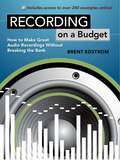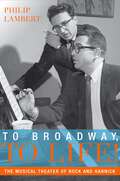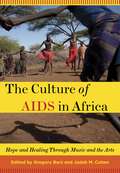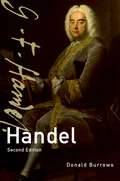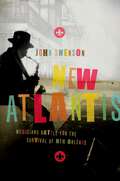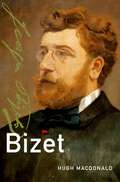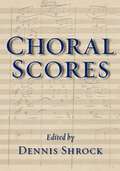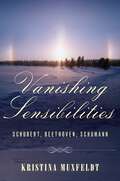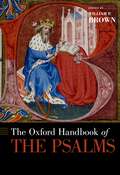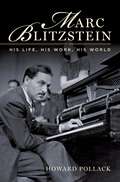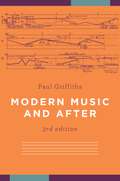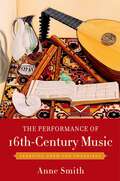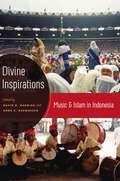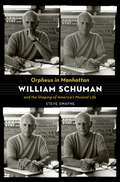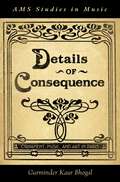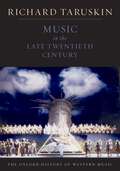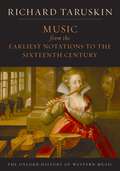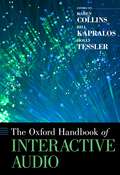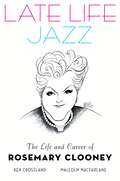- Table View
- List View
Recording on a Budget: How to Make Great Audio Recordings Without Breaking the Bank
by Brent EdstromAudio recordings are the calling card with which musicians share and promote their work so a knowledge of recording techniques and technologies is essential to the 21st century musician. Recording On a Budget provides a comprehensive introduction to the recording arts from a budget-conscious perspective. Written by a professional musician and educator, this book is ideal for musicians, educators, music students, songwriters and hobbyists. A central theme of the book is that it is possible to make quality recordings with a modest selection of recording tools. Chapters cover the selection and use of all of the components of a project studio including microphones, mixer, computer, digital audio workstation software, and signal processors. Additional chapters provide a solid foundation in acoustics, audio recording, podcasting, mixing and mastering. The final chapter of the book features do-it-yourself projects that can be completed with a modest selection of tools. Most musicians have developed their ears to a high level so a special focus is placed on the development of recording technique through experimentation and the application of critical listening skills. The book is supported by an online resource of nearly 250 audio excerpts detailing all of the primary topics of the book. Recording on a Budget is ideal for: · Musicians who are interested in recording a quality CD or demo · Choir, orchestra, and band directors who want to record vocal or instrumental ensemble · Student performers and composers who wish to record a performance or produce their own music · Bands interested in recording live concerts or recording an album in a home studio · Videographers interested in recording location sound, voice-overs or music · Songwriters who wish to produce a quality demo · Podcasters and ALL who want to make quality recordings without spending fortunes on equipment. Readers will learn · to cut budget corners without sacrificing audio quality · to choose the right microphone for the job (and where to place it) · to assemble an equipment rack, mixing desk, and speakers stand · to avoid common mistakes · And to be creative and have fun with recording technology Visit the companion website at www.oup.com/us/recordingonabudget for free selection of sample recordings!
To Broadway, To Life!: The Musical Theater of Bock and Harnick (Broadway Legacies)
by Philip LambertTo Broadway, To Life! The Musical Theater of Bock and Harnick is the first complete book about these creative figures, one of Broadway's most important songwriting teams. The book draws from personal interviews with Bock and Harnick themselves to offer an in-depth exploration their shows, including Fiddler on the Roof, She Loves Me, and Fiorello!, and their greater place in musical theater history.
The Culture of AIDS in Africa: Hope and Healing Through Music and the Arts
by Gregory Barz Judah M. CohenThe Culture of AIDS in Africa enters into the many worlds of expression brought forth across this vast continent by the ravaging presence of HIV/AIDS. Africans and non-Africans, physicians and social scientists, journalists and documentarians share here a common and essential interest in understanding creative expression in crushing and uncertain times. They investigate and engage the social networks, power relationships, and cultural structures that enable the arts to convey messages of hope and healing, and of knowledge and good counsel to the wider community. And from Africa to the wider world, they bring intimate, inspiring portraits of the performers, artists, communities, and organizations that have shared with them their insights and the sense they have made of their lives and actions from deep within this devastating epidemic. Covering the wide expanse of the African continent, the 30 chapters include explorations of, for example, the use of music to cope with AIDS; the relationship between music, HIV/AIDS, and social change; visual approaches to HIV literacy; radio and television as tools for "edutainment;" several individual artists' confrontations with HIV/AIDS; various performance groups' response to the epidemic; combating HIV/AIDS with local cultural performance; and more. Source material, such as song lyrics and interviews, weaves throughout the collection, and contributions by editors Gregory Barz and Judah M. Cohen bookend the whole, to bring together a vast array of perspectives and sources into a nuanced and profoundly affective portrayal of the intricate relationship between HIV/AIDS and the arts in Africa.
Handel (Master Musicians Series)
by Donald BurrowsHandel is one of the most remarkable figures in the history of western music. His compositions form one of the peaks of creative achievement in the Baroque period, and cover a remarkable range: full-scale Italian operas and English oratorios (including Messiah), but also shorter works such as the Water Music and the Coronation Anthem Zadok the Priest. His compositional processes were often complex, but could result in accessible and memorable 'hit tunes', such as the aria that subsequently became famous as 'Handel's Largo'. His life and career were as remarkable as his music. Born in Germany to a family that reputedly tried to discourage his initial interest in music, he broke away to seek his fortune in Italian opera, and proceeded to gain first-hand experience of the latest Italian styles in Rome, Florence, Venice and Naples. A series of career moves brought him via Hanover to London, where he eventually settled and dominated the city's musical life for half a century. There he quickly made his mark in English church music as well as Italian opera, and eventually created two new musical genres--English theatre oratorio and the organ concerto. Handel is important also because, as a musician, he also became a significant public figure. In Rome he attracted the patronage of princes and cardinals; soon after his arrival in London he appeared at the court of Queen Anne, and he subsequently enjoyed substantial support from the "Hanoverian" royal family. He survived turbulent periods in the musical and political life of London, reached a wider public through publications of his music, died a rich man and was buried in Westminster Abbey. This biography provides a comprehensive and balanced account of both the man and his music, drawing on the unusually rich legacy of documentary and musical sources from Handel's lifetime. This new edition of a book that has been recognized as a 'classic' biography of Handel, reliable on the factual details of the composer's life and comprehensive in the coverage of his music, incorporates a great deal of new material. The last half century has seen a great renewal of research on the circumstances of Handel's life, and a major expansion in performances and recordings of his music. The book brings together the results of this scholarly activity, and is informed by wide experience of modern performances of Handel's music, including the revival of his operas and experimentation with 'authentic' performance practices.
New Atlantis: Musicians Battle for the Survival of New Orleans
by John SwensonAt its most intimate level, music heals our emotional wounds and inspires us. At its most public, it unites people across cultural boundaries. But can it rebuild a city? That's the central question posed in New Atlantis, journalist John Swenson's beautifully detailed account of the musical artists working to save America's most colorful and troubled metropolis: New Orleans. The city has been threatened with extinction many times during its three-hundred-plus-year history by fire, pestilence, crime, flood, and oil spills. Working for little money and in spite of having lost their own homes and possessions to Katrina, New Orleans's most gifted musicians--including such figures as Dr. John, the Neville Brothers, "Trombone Shorty," and Big Chief Monk Boudreaux--are fighting back against a tidal wave of problems: the depletion of the wetlands south of the city (which are disappearing at the rate of one acre every hour), the violence that has made New Orleans the murder capitol of the U.S., the waning tourism industry, and above all the continuing calamity in the wake of Hurricane Katrina (or, as it is known in New Orleans, the "Federal Flood"). Indeed, most of the neighborhoods that nurtured the indigenous music of New Orleans were destroyed in the flood, and many of the elder statesmen have died or been incapacitated since then, but the musicians profiled here have stepped up to fill their roles. New Atlantis is their story. Packed with indelible portraits of individual artists, informed by Swenson's encyclopedic knowledge of the city's unique and varied music scene--which includes jazz, R&B, brass band, rock, and hip hop--New Atlantis is a stirring chronicle of the valiant efforts to preserve the culture that gives New Orleans its grace and magic.
Bizet (Master Musicians Series)
by Hugh MacdonaldToday Georges Bizet is most immediately recognized as the composer of the acclaimed opera Carmen. One of the most frequently performed operas for over a century, Carmen explores concepts such as the femme fatale and murderous jealousy with vivacity, color, and a wealth of melody. Yet it is only one act in Bizet's story. In Bizet, renowned musicologist Hugh Macdonald goes beyond the composer's most famous opera to take an in-depth look at his entire life and oeuvre. In so doing, Macdonald identifies a number of previously unknown pieces by Bizet, assembling the first comprehensive catalogue of the composer's work. Incorporating these little-known pieces with a thorough reading of primary sources, Macdonald considers the latest in Bizet scholarship to create a complete biography of the composer. Revealing the true extent of Bizet's work as arranger and transcriber, Macdonald sheds light on the composer's complex relationships with his contemporaries, and traces the strange misrepresentation of Bizet's work by French publishers and opera houses in the 1880s, when Carmen rose to worldwide popularity ten years after the composer's early death. The first biography of Bizet in the Master Musicians series in nearly four decades, Bizet will be essential reading for students and scholars of nineteenth-century opera, as well as for Carmen devotees and opera fans.
Choral Scores
by Dennis ShrockChoral Scores is an anthology of music exemplifying distinctive choral repertoire by the most noteworthy composers throughout the history of Western music. A companion volume to Denis Shrock's Choral Repertoire (Oxford 2009), it presents works of salient importance to the development of choral music in Western culture, representing the music of the composers, eras, and movements discussed most prominently in that volume. Including 132 compositions by 124 different composers, each presented unabridged and in full score, and spanning the entirety of Western music history, from the medieval era through the twentieth century, and into the twenty-first, Choral Scores is the most thorough, and up-to-date collection of choral music available. Complete with an appendix offering literal translations of texts, as well as composer and genre indices, Choral Scores is an essential reference for choral scholars, teachers, and students alike.
Vanishing Sensibilities: Schubert, Beethoven, Schumann
by Kristina MuxfeldtVanishing Sensibilities examines once passionate cultural concerns that shaped music of Schubert, Beethoven, Schumann, and works of their contemporaries in drama or poetry. Music, especially music with text, was a powerful force in lively ongoing conversations about the nature of liberty, which included such topics as the role of consent in marriage, same-sex relationships, freedom of the press, and the freedom to worship (or not). Among the most common vehicles for stimulating debate about pressing social concerns were the genres of historical drama, and legend or myth, whose stories became inflected in fascinating ways during the Age of Metternich. Interior and imagined worlds, memories and fantasies, were called up in purely instrumental music, and music was privately celebrated for its ability to circumvent the restrictions that were choking the verbal arts. Author Kristina Muxfeldt invites us to listen in on these cultural conversations, dating from a time when the climate of censorship made the tone of what was said every bit as important as its literal content. At this critical moment in European history such things as a performer's delivery, spontaneous improvisation, or the demeanor of the music could carry forbidden messages of hope and political resistance--flying under the censor's radar like a carrier pigeon. Rather than trying to decode or fix meanings, Muxfeldt concerns herself with the very mechanisms of their communication, and she confronts distortions to meaning that form over time as the cultural or political pressures shaping the original expression fade and are eventually forgotten. In these pages are accounts of works successful in their own time alongside others that failed to achieve more than a liminal presence, among them Schubert's Alfonso und Estrella and his last opera project Der Graf von Gleichen, whose libretto was banned even before Schubert set to work composing it. Enlivening the narrative are generous music examples, reproductions of artwork, and facsimiles of autograph material.
Marc Blitzstein: His Life, His Work, His World
by Howard PollackA composer and lyricist of enormous innovation and influence, Marc Blitzstein remains one of the most versatile and fascinating figures in the history of American music, his creative output running the gamut from films scores and Broadway operas to art songs and chamber pieces. A prominent leftist and social maverick, Blitzstein constantly pushed the boundaries of convention in mid-century America in both his work and his life. Award-winning music historian Howard Pollack's new biography covers Blitzstein's life in full, from his childhood in Philadelphia to his violent death in Martinique at age 58. The author describes how this student of contemporary luminaries Nadia Boulanger and Arnold Schoenberg became swept up in the stormy political atmosphere of the 1920s and 1930s and throughout his career walked the fine line between his formal training and his populist principles. Indeed, Blitzstein developed a unique sound that drew on everything contemporary, from the high modernism of Stravinsky and Hindemith to jazz and Broadway show tunes. Pollack captures the astonishing breadth of Blitzstein's work--from provocative operas like The Cradle Will Rock, No for an Answer, and Regina, to the wartime Airborne Symphony composed during his years in service, to lesser known ballets, film scores, and stage works. A courageous artist, Blitzstein translated Bertolt Brecht and Kurt Weill's The Threepenny Opera during the heyday of McCarthyism and the red scare, and turned it into an off-Broadway sensation, its "Mack the Knife" becoming one of the era's biggest hits. Beautifully written, drawing on new interviews with friends and family of the composer, and making extensive use of new archival and secondary sources, Marc Blitzstein presents the most complete biography of this important American artist.
Modern Music and After
by Paul GriffithsOver three decades, Paul Griffiths's survey has remained the definitive study of music since the Second World War; this fully revised and updated edition re-establishes Modern Music and After as the preeminent introduction to the music of our time. The disruptions of the war, and the struggles of the ensuing peace, were reflected in the music of the time: in Pierre Boulez's radical reformation of compositional technique and in John Cage's development of zen music; in Milton Babbitt's settling of the serial system and in Dmitry Shostakovich's unsettling symphonies; in Karlheinz Stockhausen's development of electronic music and in Luigi Nono's pursuit of the universally human, in Iannis Xenakis's view of music as sounding mathematics and in Luciano Berio's consideration of it as language. The initiatives of these composers and their contemporaries opened prospects that haven't yet stopped unfolding. This constant expansion of musical thinking since 1945 has left us with no singular history of music; Griffiths's study accordingly follows several different paths, showing how and why they converge and diverge. This new edition of Modern Music and After discusses not only the music of the fifteen years that have passed since the previous edition, but also the recent explosion of scholarly interest in the latter half of the twentieth century. In particular, the book has been expanded to incorporate the variety of responses to the modernist impasse experienced by composers of the 1980s and 1990s. Griffiths then moves the book into the twenty-first century as he examines such highly influential composers as Helmut Lachenmann and Salvatore Sciarrino. For its breadth, wealth of detail, and characteristic wit and clarity, the third edition of Modern Music and After is required reading for the student and the enquiring listener.
The Performance of 16th-Century Music: Learning from the Theorists
by Anne SmithMost modern performers, trained on the performance practices of the Classical and Romantic periods, come to the music of the Renaissance with well-honed but anachronistic ideas. Fundamental differences between 16th-century repertoire and that of later epochs thus tend to be overlooked-yet it is just these differences which can make a performance truly stunning. The Performance of 16th-Century Music will enable the performer to better understand this music and advance their technical and expressive abilities. Early music specialist Anne Smith outlines several major areas of technical knowledge and skill needed to perform the music of this period. She takes readers through the significance of part-book notation; solmization; rhythmic flexibility; and elements of structure in relation to rhetoric of the time; while familiarizing them with contemporary criteria and standards of excellence for performance. Through The Performance of 16th-Century Music, today's musicians will gain fundamental insight into how 16th-century polyphony functions, and the tools necessary to perform this repertoire to its fullest, most glorious potential.
Divine Inspirations: Music and Islam in Indonesia
by David Harnish Anne RasmussenDivine Inspirations: Music and Islam in Indonesia brings together the work of 11 international scholars into an unprecedented volume focused on religion and performance in a nation celebrated for its extraordinary arts, religious diversity, and natural beauty. The resulting collection provides a panoramic view of Indonesia's Islamic arts in a variety of settings and communities. Together the authors address how history, politics, spirituality, and gender are expressed through performance and how Indonesian Islamic culture intersects with the ideology and practice of nationalism. Unique and engaging, Divine Inspirations will fascinate readers interested in Southeast Asia, the Middle East, Islam, world religions, global discourse, and music, arts and ritual.
Orpheus in Manhattan: William Schuman and the Shaping of America's Musical Life
by Steve SwayneWinner of the ASCAP Nicolas Slonimsky Award for Outstanding Musical Biography The musical landscape of New York City and the United States of America would look quite different had it not been for William Schuman. Orpheus in Manhattan, a fully objective and comprehensive biography of Schuman, portrays a man who had a profound influence upon the artistic and political institutions of his day and beyond. Steve Swayne draws heavily upon Schuman's letters, writings, and manuscripts as well as unprecedented access to archival recordings and previously unknown correspondence. The winner of the first Pulitzer Prize in Music, Schuman composed music that is rhythmically febrile, harmonically pungent, melodically long-breathed, and timbrally brilliant, and Swayne offers an astute analysis of his work, including many unpublished music scores. Swayne also describes Schuman's role as president of the Juilliard School of Music and of Lincoln Center, tracing how he both expanded the boundaries of music education and championed the performing arts. Filled with new discoveries and revisions of the received historical narrative, Orpheus in Manhattan confirms Schuman as a major figure in America's musical life.
Recording on a Budget: How to Make Great Audio Recordings Without Breaking the Bank
by Brent EdstromAudio recordings are the calling card with which musicians share and promote their work so a knowledge of recording techniques and technologies is essential to the 21st century musician. Recording On a Budget provides a comprehensive introduction to the recording arts from a budget-conscious perspective. Written by a professional musician and educator, this book is ideal for musicians, educators, music students, songwriters and hobbyists. A central theme of the book is that it is possible to make quality recordings with a modest selection of recording tools. Chapters cover the selection and use of all of the components of a project studio including microphones, mixer, computer, digital audio workstation software, and signal processors. Additional chapters provide a solid foundation in acoustics, audio recording, podcasting, mixing and mastering. The final chapter of the book features do-it-yourself projects that can be completed with a modest selection of tools. Most musicians have developed their ears to a high level so a special focus is placed on the development of recording technique through experimentation and the application of critical listening skills. The book is supported by an online resource of nearly 250 audio excerpts detailing all of the primary topics of the book. Recording on a Budget is ideal for: · Musicians who are interested in recording a quality CD or demo · Choir, orchestra, and band directors who want to record vocal or instrumental ensemble · Student performers and composers who wish to record a performance or produce their own music · Bands interested in recording live concerts or recording an album in a home studio · Videographers interested in recording location sound, voice-overs or music · Songwriters who wish to produce a quality demo · Podcasters and ALL who want to make quality recordings without spending fortunes on equipment. Readers will learn · to cut budget corners without sacrificing audio quality · to choose the right microphone for the job (and where to place it) · to assemble an equipment rack, mixing desk, and speakers stand · to avoid common mistakes · And to be creative and have fun with recording technology Visit the companion website at www.oup.com/us/recordingonabudget for free selection of sample recordings!
Modern Music and After
by Paul GriffithsOver three decades, Paul Griffiths's survey has remained the definitive study of music since the Second World War; this fully revised and updated edition re-establishes Modern Music and After as the preeminent introduction to the music of our time. The disruptions of the war, and the struggles of the ensuing peace, were reflected in the music of the time: in Pierre Boulez's radical reformation of compositional technique and in John Cage's development of zen music; in Milton Babbitt's settling of the serial system and in Dmitry Shostakovich's unsettling symphonies; in Karlheinz Stockhausen's development of electronic music and in Luigi Nono's pursuit of the universally human, in Iannis Xenakis's view of music as sounding mathematics and in Luciano Berio's consideration of it as language. The initiatives of these composers and their contemporaries opened prospects that haven't yet stopped unfolding. This constant expansion of musical thinking since 1945 has left us with no singular history of music; Griffiths's study accordingly follows several different paths, showing how and why they converge and diverge. This new edition of Modern Music and After discusses not only the music of the fifteen years that have passed since the previous edition, but also the recent explosion of scholarly interest in the latter half of the twentieth century. In particular, the book has been expanded to incorporate the variety of responses to the modernist impasse experienced by composers of the 1980s and 1990s. Griffiths then moves the book into the twenty-first century as he examines such highly influential composers as Helmut Lachenmann and Salvatore Sciarrino. For its breadth, wealth of detail, and characteristic wit and clarity, the third edition of Modern Music and After is required reading for the student and the enquiring listener.
The Performance of 16th-Century Music: Learning from the Theorists
by Anne SmithMost modern performers, trained on the performance practices of the Classical and Romantic periods, come to the music of the Renaissance with well-honed but anachronistic ideas. Fundamental differences between 16th-century repertoire and that of later epochs thus tend to be overlooked-yet it is just these differences which can make a performance truly stunning. The Performance of 16th-Century Music will enable the performer to better understand this music and advance their technical and expressive abilities. Early music specialist Anne Smith outlines several major areas of technical knowledge and skill needed to perform the music of this period. She takes readers through the significance of part-book notation; solmization; rhythmic flexibility; and elements of structure in relation to rhetoric of the time; while familiarizing them with contemporary criteria and standards of excellence for performance. Through The Performance of 16th-Century Music, today's musicians will gain fundamental insight into how 16th-century polyphony functions, and the tools necessary to perform this repertoire to its fullest, most glorious potential.
Divine Inspirations: Music and Islam in Indonesia
by Anne K. Rasmussen David D. HarnishDivine Inspirations: Music and Islam in Indonesia brings together the work of 11 international scholars into an unprecedented volume focused on religion and performance in a nation celebrated for its extraordinary arts, religious diversity, and natural beauty. The resulting collection provides a panoramic view of Indonesia's Islamic arts in a variety of settings and communities. Together the authors address how history, politics, spirituality, and gender are expressed through performance and how Indonesian Islamic culture intersects with the ideology and practice of nationalism. Unique and engaging, Divine Inspirations will fascinate readers interested in Southeast Asia, the Middle East, Islam, world religions, global discourse, and music, arts and ritual.
Orpheus in Manhattan: William Schuman and the Shaping of America's Musical Life
by Steve SwayneWinner of the ASCAP Nicolas Slonimsky Award for Outstanding Musical Biography The musical landscape of New York City and the United States of America would look quite different had it not been for William Schuman. Orpheus in Manhattan, a fully objective and comprehensive biography of Schuman, portrays a man who had a profound influence upon the artistic and political institutions of his day and beyond. Steve Swayne draws heavily upon Schuman's letters, writings, and manuscripts as well as unprecedented access to archival recordings and previously unknown correspondence. The winner of the first Pulitzer Prize in Music, Schuman composed music that is rhythmically febrile, harmonically pungent, melodically long-breathed, and timbrally brilliant, and Swayne offers an astute analysis of his work, including many unpublished music scores. Swayne also describes Schuman's role as president of the Juilliard School of Music and of Lincoln Center, tracing how he both expanded the boundaries of music education and championed the performing arts. Filled with new discoveries and revisions of the received historical narrative, Orpheus in Manhattan confirms Schuman as a major figure in America's musical life.
Details of Consequence: Ornament, Music, and Art in Paris (AMS Studies in Music)
by Gurminder Kaur BhogalDetails of Consequence examines a trait that is taken for granted and rarely investigated in fin-de-siècle French music: ornamental extravagance. Considering why such composers as Claude Debussy, Maurice Ravel, Gabriel Fauré, Igor Stravinsky, and Erik Satie, turned their attention to the seemingly innocuous and allegedly superficial phenomenon of ornament at pivotal moments of their careers, this book shows that the range of decorative languages and unusual ways in which ornament is manifest in their works doesn't only suggest a willingness to decorate or render music beautiful. Rather, in keeping with the sorts of changes that decorative expression was undergoing in the work of Eugène Grasset, Pierre Bonnard, Henri Matisse, and other painters, composers also invested their creative energies in re-imagining ornament, relying on a variety of decorative techniques to emphasize what was new and unprecedented in their treatment of form, meter, rhythm, melody, and texture. Furthermore, abundant displays of ornament in their music served to privilege associations that had been previously condemned in Western philosophy such as femininity, sensuality, exoticism, mystery, and fantasy. Alongside specific visual examples, author Gurminder Kaur Bhogal offers analyses of piano pieces, orchestral music, chamber works, and compositions written for the Ballets Russes to highlight the disorienting effect of musical experiments with ornament. Acknowledging the willingness of listeners to borrow vocabulary from the visual arts when describing decorative music, Bhogal probes the formation of art-music metaphors, and studies the cognitive impetus behind tendencies to posit stylistic parallels. She further illustrates that the rising expressive status of ornament in music and art had broad social and cultural implications as evidenced by its widespread involvement in debates on French identity, style, aesthetics, and progress. Drawing on a range of recent scholarship in the humanities at large, including studies in feminist theory, nationalism, and orientalism, Details of Consequence is an intensely interdisciplinary look at an important facet of fin-de-siècle French music.
Music in the Late Twentieth Century: The Oxford History of Western Music
by Richard TaruskinThe universally acclaimed and award-winning Oxford History of Western Music is the eminent musicologist Richard Taruskin's provocative, erudite telling of the story of Western music from its earliest days to the present. Each book in this superlative five-volume set illuminates-through a representative sampling of masterworks-the themes, styles, and currents that give shape and direction to a significant period in the history of Western music. Music in the Late Twentieth Century is the final installment of the set, covering the years from the end of World War II to the present. In these pages, Taruskin illuminates the great compositions of recent times, offering insightful analyses of works by Aaron Copland, John Cage, Milton Babbitt, Benjamin Britten, Steve Reich, and Philip Glass, among many others. He also looks at the impact of electronic music and computers, the rise of pop music and rock 'n' roll, the advent of postmodernism, and the contemporary music of Laurie Anderson, John Zorn, and John Adams. Laced with brilliant observations, memorable musical analysis, and a panoramic sense of the interactions between history, culture, politics, art, literature, religion, and music, this book will be essential reading for anyone who wishes to understand this rich and diverse period.
Music in the Late Twentieth Century: The Oxford History of Western Music
by Richard TaruskinThe universally acclaimed and award-winning Oxford History of Western Music is the eminent musicologist Richard Taruskin's provocative, erudite telling of the story of Western music from its earliest days to the present. Each book in this superlative five-volume set illuminates-through a representative sampling of masterworks-the themes, styles, and currents that give shape and direction to a significant period in the history of Western music. Music in the Late Twentieth Century is the final installment of the set, covering the years from the end of World War II to the present. In these pages, Taruskin illuminates the great compositions of recent times, offering insightful analyses of works by Aaron Copland, John Cage, Milton Babbitt, Benjamin Britten, Steve Reich, and Philip Glass, among many others. He also looks at the impact of electronic music and computers, the rise of pop music and rock 'n' roll, the advent of postmodernism, and the contemporary music of Laurie Anderson, John Zorn, and John Adams. Laced with brilliant observations, memorable musical analysis, and a panoramic sense of the interactions between history, culture, politics, art, literature, religion, and music, this book will be essential reading for anyone who wishes to understand this rich and diverse period.
Music from the Earliest Notations to the Sixteenth Century: The Oxford History of Western Music
by Richard TaruskinThe universally acclaimed and award-winning Oxford History of Western Music is the eminent musicologist Richard Taruskin's provocative, erudite telling of the story of Western music from its earliest days to the present. Each book in this superlative five-volume set illuminates-through a representative sampling of masterworks- the themes, styles, and currents that give shape and direction to a significant period in the history of Western music. This first volume in Richard Taruskin's majestic history, Music from the Earliest Notations to the Sixteenth Century , sweeps across centuries of musical innovation to shed light on the early forces that shaped the development of the Western classical tradition. Beginning with the invention of musical notation more than a thousand years ago, Taruskin addresses topics such as the legend of Saint Gregory and Gregorian chant, Augustine's and Boethius's thoughts on music, the liturgical dramas of Hildegard of Bingen, the growth of the music printing business, the literary revolution and the English madrigal, the influence of the Reformation and the Counter-Reformation, and the operas of Monteverdi. Laced with brilliant observations, memorable musical analysis, and a panoramic sense of the interactions between history, culture, politics, art, literature, religion, and music, this book will be essential reading for anyone who wishes to understand this rich and diverse period.
The Oxford Handbook of Interactive Audio (Oxford Handbooks)
As audiences are increasingly no longer solely listeners but also active producer-consumers, and as video games and other interactive systems increasingly permeate our daily lives, understanding interactivity and its impact on the audience has never been more important. A collection of newly commissioned chapters on interactivity in music and sound edited by preeminent scholars in the field, this book marks the beginning of a journey into understanding the ways in which we interact with sound, and offers a new set of analytical tools for the growing field of interactive audio. What does it mean to interact with sound? How does interactivity alter our experience as creators and listeners? What makes interactive audio different from non-interactive audio? Where does interacting with audio fit into our understanding of sound and music? What does the future hold for interactive media when it comes to our musical and sonic experiences? And how do we begin to approach interactive audio from a theoretical perspective? The Oxford Handbook of Interactive Audio answers these questions by exploring the full range of interactive audio in video games, performance, education, environmental design, toys, and artistic practice. Examining these questions from a range of approaches -- technological, emotional, psychological, and physical -- the book provides a thorough overview of the fascinating experience of interactive sound.
Late Life Jazz: The Life and Career of Rosemary Clooney
by Ken Crossland Malcolm MacfarlaneWhen people hear the name "Clooney," they automatically think of George Clooney, one of Hollywood's biggest stars. But it was his aunt Rosemary who first catapulted the name into bright lights with a string of hit songs in the 1950s and a starring role alongside Bing Crosby in the immortal "White Christmas." Drawing on interviews with family members, managers, promoters, and the jazz musicians who worked with her, as well as contemporary newspaper articles and reviews, Late Life Jazz tells the unsung story of one of America's finest singers, Rosemary Clooney. Ken Crossland and Malcolm Macfarlane trace Rosemary's life from her hardscrabble beginnings in Maysville Kentucky, through her first performances singing with the Barney Rapp Band in Cincinnati, through her rise to pop stardom in the early 1950s when she topped the Hit Parade with songs such as "Come On-a My House," "Tenderly," and "Half As Much." By the time the 1960s arrived, however, personal turmoil, fueled by depression and an addiction to prescription medication, almost destroyed Clooney's career-and her life. She underwent years of therapy and recuperation before she was able to perform again in the early 1970s. Few expected her to be anything more than a baroness of nostalgia, but Rosemary had other ideas. Rejuvenated by a series of concerts alongside her friend and mentor, Bing Crosby, she found a new medium in the midst of America's finest jazz musicians, building a second career and with it a reputation as one of the finest interpreters of the Great American Songbook. Vividly written and painstakingly researched, Late Life Jazz explores the rise, fall, and final triumph of Clooney the First, Aunt Rosemary, jazz singer par excellence.
